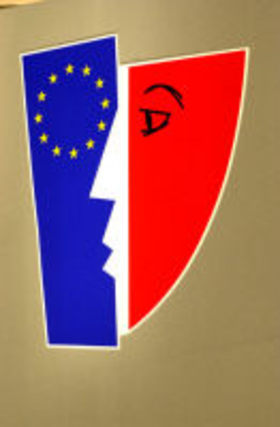Presidency of the Council

- French Presidency logo (Photo: French EU Presidency)
The Council is led by a presidency, which rotates between the member states every 6 months.
Notes
- In practice, the smaller EU countries have often run the best EU presidencies because they know they cannot focus upon their own interests while they hold the role. When a country seeks to give priority to its own interests while holding the EU presidency, the other Member States get suspicious and policy consensus becomes difficult.
This is why smaller countries consider the EU presidency primarily as a technical task with the aim to establish as many compromises as possible and to move forward the common agenda for EU integration. - An EU presidency always uses the services of the permanent Council Secretariat but chairs all meetings of the different ministerial councils and working groups.
- A compromise between different conceptions of EU presidencies in the future could consist in allowing the different working groups and Councils to elect their own chair among their members and only rotate some of the different functional chairmanships.
Future
The enlargement has been used as an argument by those who advocate the abolition of rotation and the introduction of permanent EU presidencies. The 2002 summits in Seville and Copenhagen worked on different compromise formulas.
In an enlarged EU of 25 or more states, an individual country may only gain the presidency once every twelve years. This would mean one EU presidency for every generation of politicians.
In the Convention, France and Germany proposed that the members of the European Council should appoint a President of the EU for five year terms, or else 2 ½ years, with the possibility of being re-elected.
Denmark proposed a permanent EU President who would rotate between small, medium, and big countries.
Most small EU countries rejected the concept of a permanent presidency because they think it will inevitably be carried out by someone from the large countries.
All the large countries wanted a permanent EU President to increase the EU’s visibility on the international scene and to prevent small EU Member States from being placed on an equal footing with the old big powers of Europe.
The Convention finally proposed a permanent presidency of the European Council. He shall be appointed by qualified majority for a renewable term of 2 1/2 years. Other Council presidencies shall be appointed using a system to be decided on unanimously, based upon equal rotation.
The order of rotation until the end of 2006:
2003:Greece (first half)
Italy (second half)
2004:
Ireland (first half)
Netherlands (second half)
2005:
Luxembourg (first half)
United Kingdom (second half)
2006:
Austria (first half)
Finland (second half)
Links
http://ue.eu.int/en/presid.htmhttp://ue.eu.int/en/summ.htm
